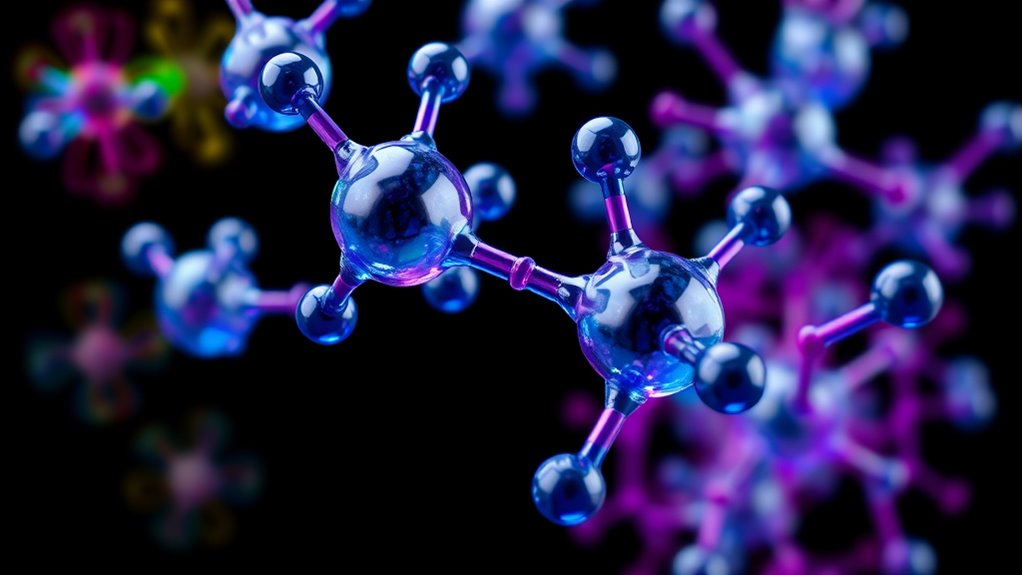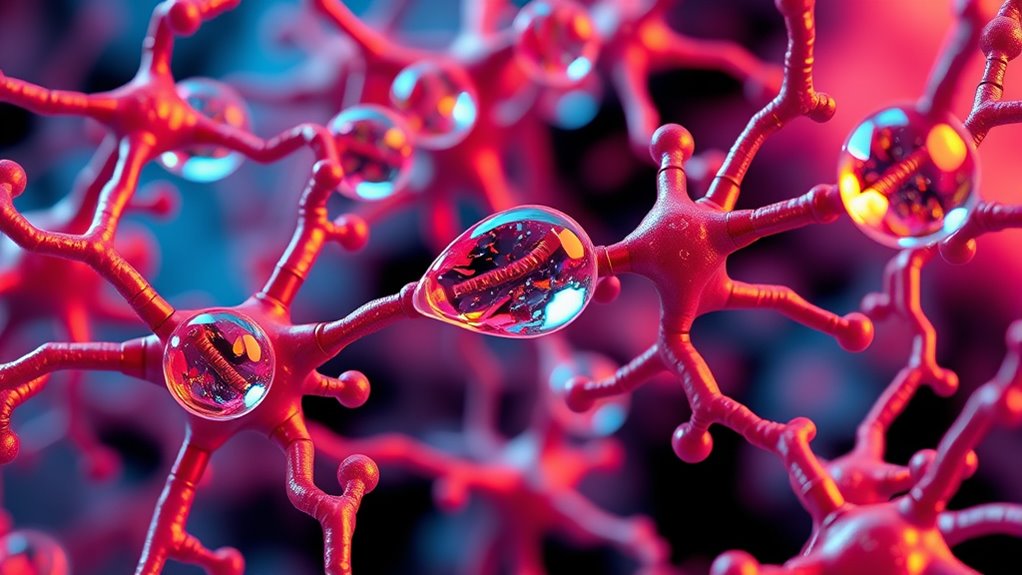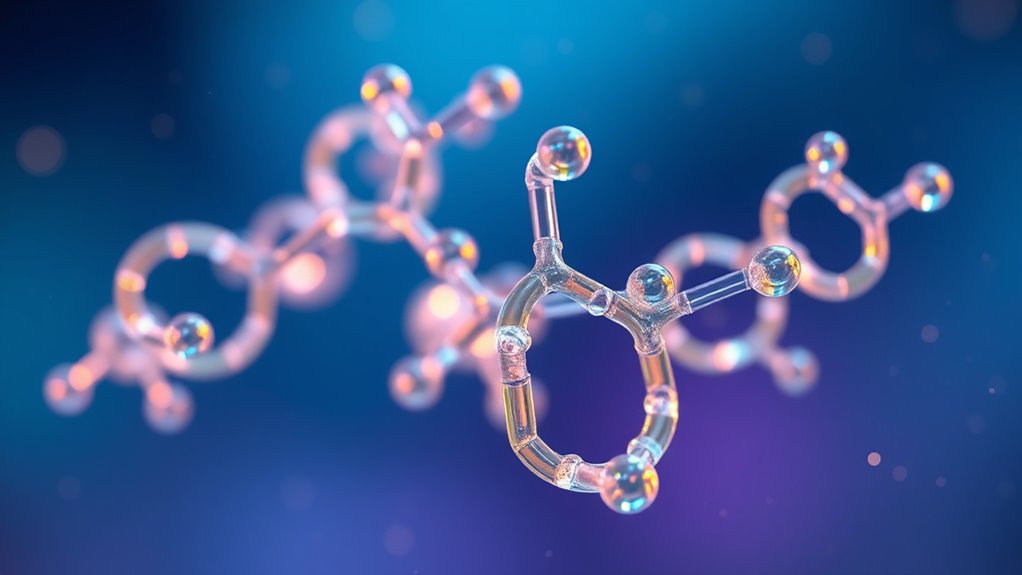Opioid molecules work by binding to specific receptors—mainly μ, δ, and κ—in your nervous system to block pain signals, providing effective relief. Their chemical structures, like morphine’s phenanthrene core, determine how well they interact with these receptors. While they offer powerful pain control, they also activate pathways linked to addiction and side effects. Understanding their chemistry and receptor interactions helps develop safer drugs—keep exploring to discover more about how these molecules balance pain relief and dependence.
Key Takeaways
- Opioid molecules bind to μ, δ, and κ receptors, activating signaling pathways that produce pain relief and can lead to dependence.
- Structural features like phenolic groups and receptor-specific residues determine ligand selectivity and binding affinity.
- Synthetic opioids such as fentanyl interact with receptor pockets through key amino acids like Asp³.³², influencing potency.
- Crystallography reveals how opioid molecules induce receptor conformational changes, guiding safer drug design.
- Modifications in opioid chemistry aim to enhance analgesia while minimizing addiction and adverse side effects.
Overview of Opioid Receptors and Their Functions

Opioid receptors are specialized proteins found in the nervous system that mediate the effects of both natural and synthetic opioids. You have four main types: mu (μ), delta (δ), kappa (κ), and nociceptin/orphanin FQ (NOP).
μ receptors, the most studied, primarily produce pain relief and euphoria. They’re involved in addiction, respiratory depression, and mood regulation.
δ receptors also contribute to analgesia and influence emotional responses, possibly offering antidepressant effects.
κ receptors are key in pain control at the spinal level but can cause dysphoria and psychotomimetic effects.
NOP receptors, related but distinct, modulate various functions without typical opioid effects. Recent research indicates that these receptor subtypes can form complexes and interact with various regulatory proteins, further diversifying their functional roles.
Additionally, understanding receptor interactions can help in developing targeted therapies that minimize side effects and improve pain management strategies.
Structural Features Influencing Ligand Selectivity

The structural features of opioid receptors play a crucial role in determining how different ligands bind selectively to each subtype. Variations in binding pockets influence ligand compatibility, with specific residues like W318 in μOR creating steric hindrance, while δOR’s leucine allows binding. Understanding receptor structure helps in designing more selective and effective ligands. Key pharmacophore elements, such as the tyrosine with a phenolic hydroxyl and positive charge, are essential for activity. Ligand “addresses,” like naltrindole’s indole, confer subtype selectivity through interactions with unique receptor residues. The core module provides efficacy, while the address module influences selectivity. Structural modifications, including extensions into subpockets and stereochemistry adjustments, enhance binding affinity and specificity. Understanding these features guides the rational design of ligands that target specific receptor subtypes, optimizing therapeutic effects and reducing side effects.
Molecular Diversity and Binding Pocket Variations

How do genetic differences shape the landscape of opioid receptor binding pockets? You should know that genetic polymorphisms subtly change amino acid sequences, which alter the shape and chemical environment of these pockets. Variations in residues can modify how ligands bind, affecting their affinity and effectiveness, leading to patient-specific responses and side effects. Genetic variations can also influence receptor expression levels, further affecting drug responses. Some mutations reduce binding strength, causing tolerance or insensitivity. Additionally, genetic differences influence receptor subtypes and their ability to form dimers or oligomers, further diversifying pocket characteristics. Receptor oligomerization can create new allosteric sites or modify existing ones, impacting ligand selectivity. This molecular diversity explains variations in drug response and highlights the complexity of designing opioids that effectively target these evolving binding pockets.
Chemical Structures and Binding Affinities of Key Opioids

Understanding the chemical structures of key opioids is essential for grasping their binding affinities at μ-opioid receptors. Natural opiates like morphine and codeine feature a phenanthrene nucleus and a six-ring morphinan backbone, with modifications such as 14-hydroxyl groups increasing affinity.
Semisynthetic derivatives like oxycodone enhance potency through 14-hydroxy substitution, while fully synthetic opioids like fentanyl rely on spacer length and lipophilicity for high affinity.
Critical interactions include a protonated tertiary amine forming a salt bridge with Asp³.³² and aromatic CH-π interactions stabilizing binding. Substituents at positions like 5 and 6 influence efficacy and side effects.
For example, fentanyl exhibits 50-100 times higher μ-OR affinity than morphine, while buprenorphine’s subnanomolar affinity results from its unique structure.
Insights From High-Resolution Receptor-Ligand Crystallography

High-resolution crystallography has revolutionized our ability to visualize opioid receptor structures at an atomic level, revealing detailed insights into ligand binding and receptor conformations. You can now see exactly how different ligands interact with specific residues within transmembrane regions, clarifying the structural determinants for binding specificity. These structures also demonstrate how ligand-induced conformational changes influence receptor activation and bias. Recent technological advances allow you to analyze both active and inactive receptor states, helping you understand how conformational changes influence receptor function. These crystal structures, combined with computational modeling, enable you to predict ligand efficacy and design better, safer drugs. They also highlight key differences among opioid receptor subtypes, guiding targeted therapy development. Continual monitoring of receptor behavior ultimately, crystallography provides a precise map for understanding ligand-receptor interactions, informing efforts to improve pain relief while minimizing adverse effects.
Receptor Activation, Desensitization, and Internalization Processes

Opioid receptors, as G protein-coupled receptors (GPCRs), initiate intracellular signaling cascades upon binding opioid agonists that lead to pain relief. Activation involves shifting from an inactive state (Σ0) to a fully active conformation (Σ4′), driven by ligand binding and structural rearrangements. This change enables the intracellular domain to recruit and activate the inhibitory Gi protein, triggering downstream effects. AI-driven content clustering can further enhance understanding of these complex signaling pathways. Multiple metastable states, separated by energy barriers, influence activation speed. Selectivity between Gi and Gs proteins depends on specific interactions, especially in the G protein’s last 21 residues, acting as a “selectivity barcode.” Continuous agonist exposure causes desensitization via phosphorylation by GRKs and arrestin binding, reducing receptor responsiveness. Internalization follows phosphorylation and arrestin recruitment, regulating receptor availability and shifting signaling pathways.
Implications for Pain Management and Addiction Treatment

The effectiveness of opioid molecules in pain management depends heavily on their ability to selectively activate µ opioid receptors, providing rapid relief for acute pain conditions. They work well for short-term nociceptive and neuropathic pain, but their benefits are limited for chronic pain beyond three months. Grocery savings strategies are important to consider for managing overall health expenses, including medications and treatments. Ultra-short and long-acting formulations help tailor treatment, especially in surgical settings. However, long-term use poses risks, including tolerance, dependence, and overdose. Overprescribing has fueled the opioid crisis, with rising overdose deaths involving both prescription and illicit opioids. To reduce addiction risks, clinicians employ multimodal strategies, prescribe the lowest effective doses, and monitor patient use closely. Advancements in understanding receptor signaling are guiding the development of safer analgesics and addiction treatments, aiming to balance pain relief with minimized liabilities.
Advances in Developing Receptor-Targeted Therapeutics

Recent advances in understanding receptor pharmacology are transforming how you develop targeted pain therapies. Peripheral opioid receptor agonists offer effective pain relief by acting outside the central nervous system, reducing risks like respiratory depression and addiction. Because these agents poorly cross the blood-brain barrier, they provide localized pain control with fewer systemic side effects. Moreover, understanding dog names can help in creating personalized therapeutic strategies that consider breed-specific responses. Knowledge of opioid receptor subtypes, such as delta and kappa, guides the design of drugs that maximize analgesia while minimizing adverse effects. Researchers are creating selective agonists and biased ligands that favor pain relief without tolerance or dependence. Additionally, innovative approaches target receptor heterodimers with multifunctional ligands, aiming to enhance efficacy and safety. These developments clearly indicate a shift toward more precise, side effect-conscious opioid therapies.
Future Directions in Opioid Research and Safer Pain Relief Options

Advances in receptor-targeted therapeutics have laid the groundwork for exploring new approaches to pain management that prioritize safety and efficacy. You’ll see a focus on developing nonaddictive alternatives, with ongoing research into safer pharmacological properties to reduce addiction risks.
Digital health tools and pharmacogenomics are emerging to personalize treatment and monitor use more effectively.
Expanding access to opioid use disorder treatments and implementing harm reduction strategies are essential public health priorities.
Technological innovations like AI and telemedicine help predict misuse and support patients.
Regulatory updates aim to balance effective pain relief with safety, ensuring responsible prescribing.
Interdisciplinary collaboration among clinicians, researchers, and policymakers remains critical to creating safer, more effective pain management options for the future.
Frequently Asked Questions
How Do Opioid Receptor Subtypes Differ in Their Signaling Pathways?
The current question asks how opioid receptor subtypes differ in their signaling pathways. You find that each subtype, like MOR, DOR, and KOR, activates distinct signaling mechanisms.
For example, MOR involves both G-protein and β-arrestin pathways, influencing pain relief and tolerance.
DOR mainly signals through G-proteins, affecting emotional regulation.
KOR has unique stress-related responses.
All these subtypes interact with other cellular pathways like MAP kinases, leading to varied effects.
What Role Do Receptor Desensitization Mechanisms Play in Addiction?
You might think receptor desensitization is minor, but it’s actually the silent villain behind addiction’s grip. When your receptors quickly become less responsive due to desensitization, you need higher doses for the same effect, fueling dependence.
This process, involving β-arrestin and receptor trafficking, hijacks your brain’s reward system, making it harder to break free. In short, desensitization ramps up tolerance, paving the way for addiction to take hold.
Can Structural Modifications Improve Opioid Selectivity and Reduce Side Effects?
You can improve opioid selectivity and reduce side effects through structural modifications. By tweaking molecular features, you target specific receptor subtypes, minimizing off-target interactions.
Chemical changes like substituting amino acids or adding functional groups help create ligands that favor beneficial pathways while avoiding adverse effects. These modifications enhance receptor binding precision, leading to safer, more effective opioids with fewer side effects and lower addiction risks.
How Do Ligand Protonation States Influence Receptor Binding Affinity?
When it comes to ligand protonation states affecting receptor binding affinity, they can make or break the deal. If the ligand’s amino groups are protonated, they form stronger electrostatic and hydrogen bonds with receptor residues, boosting affinity.
Conversely, unprotonated ligands may bind less tightly. So, adjusting protonation states based on tissue pH can tip the scales, influencing whether a drug acts as an agonist or antagonist.
Are There Non-Opioid Receptor Targets for Pain Relief With Less Addiction Risk?
You’re wondering if there are non-opioid targets for pain relief that pose less addiction risk. Researchers are exploring options like CB1 receptors activated by cannabinoids, which can ease chronic pain without involving opioid pathways but may cause side effects.
Immune cell targets, such as EMA401, modulate pain without addiction potential.
Sodium channel blockers like Journavx reduce pain signals at the periphery, offering effective, safer alternatives.
GPCRs are also promising, with AI helping identify new non-addictive therapies.
Conclusion
Think of the opioid system as a complex lock-and-key puzzle. By understanding the molecular intricacies, you can uncover new pathways to effective pain relief while avoiding the dangerous traps of addiction. As research deepens, you’re standing at the crossroads of innovation, shaping a future where safer, more targeted therapies become the key to healing without harm. Together, you can help turn the tide toward smarter, more compassionate pain management.









